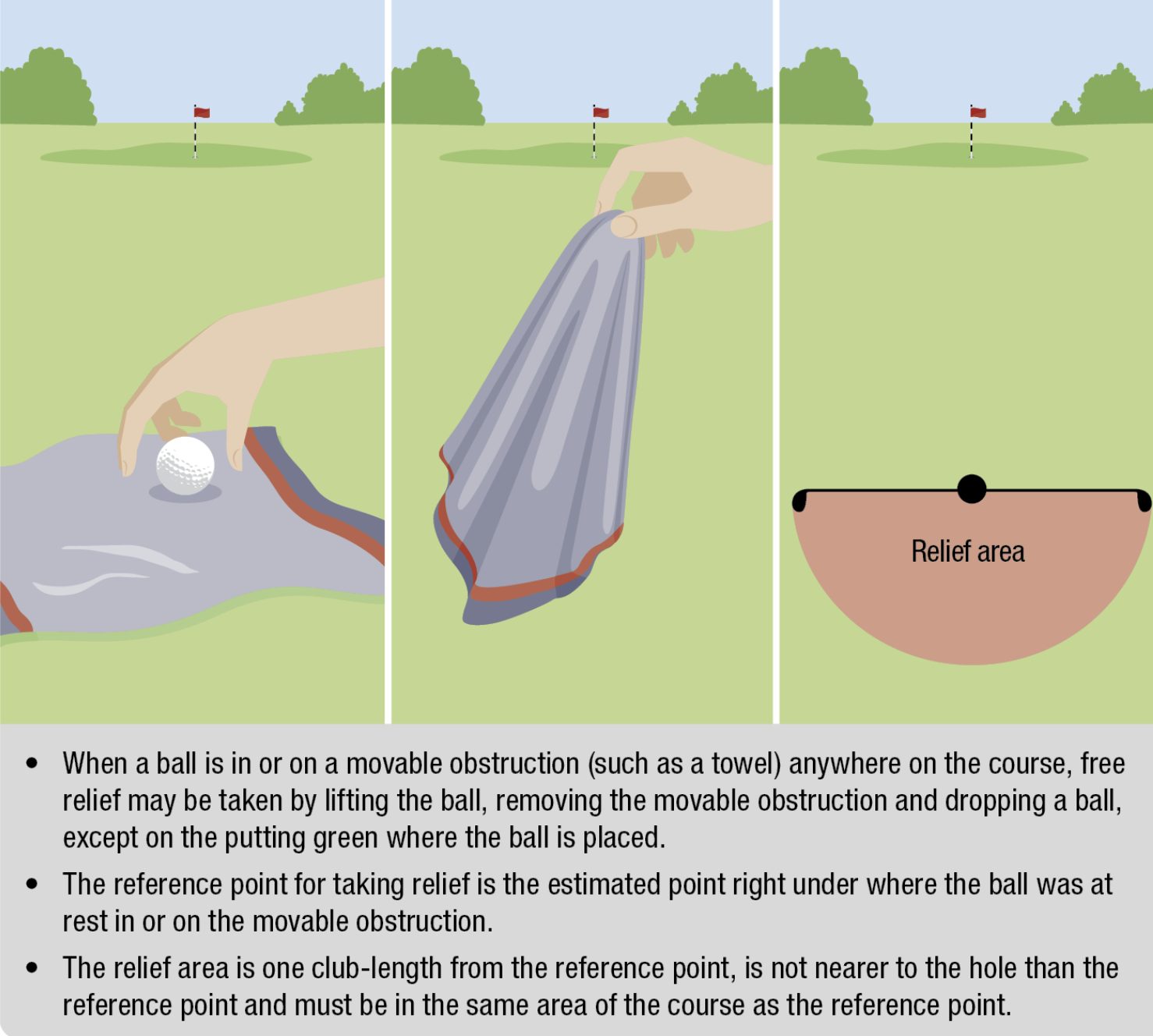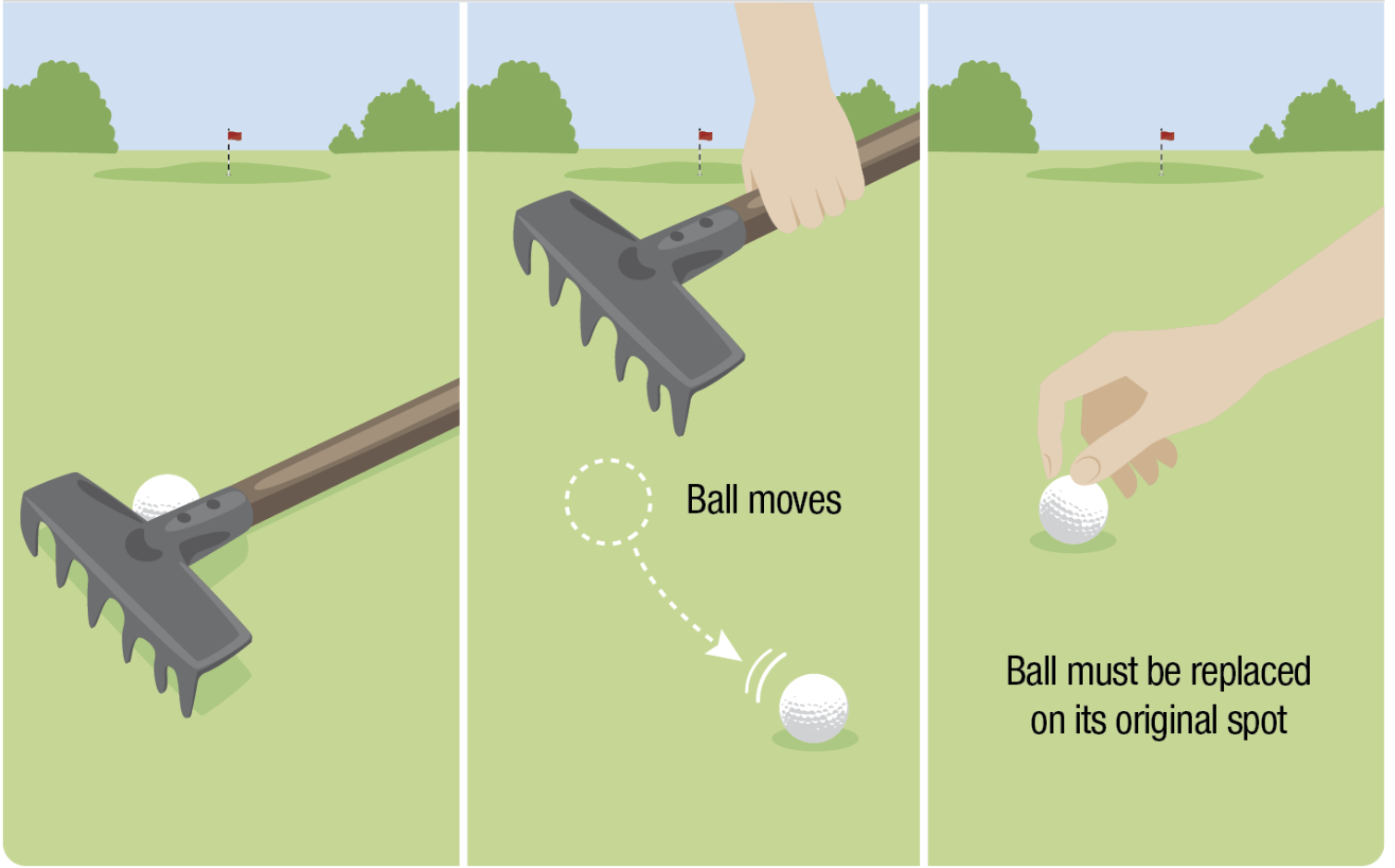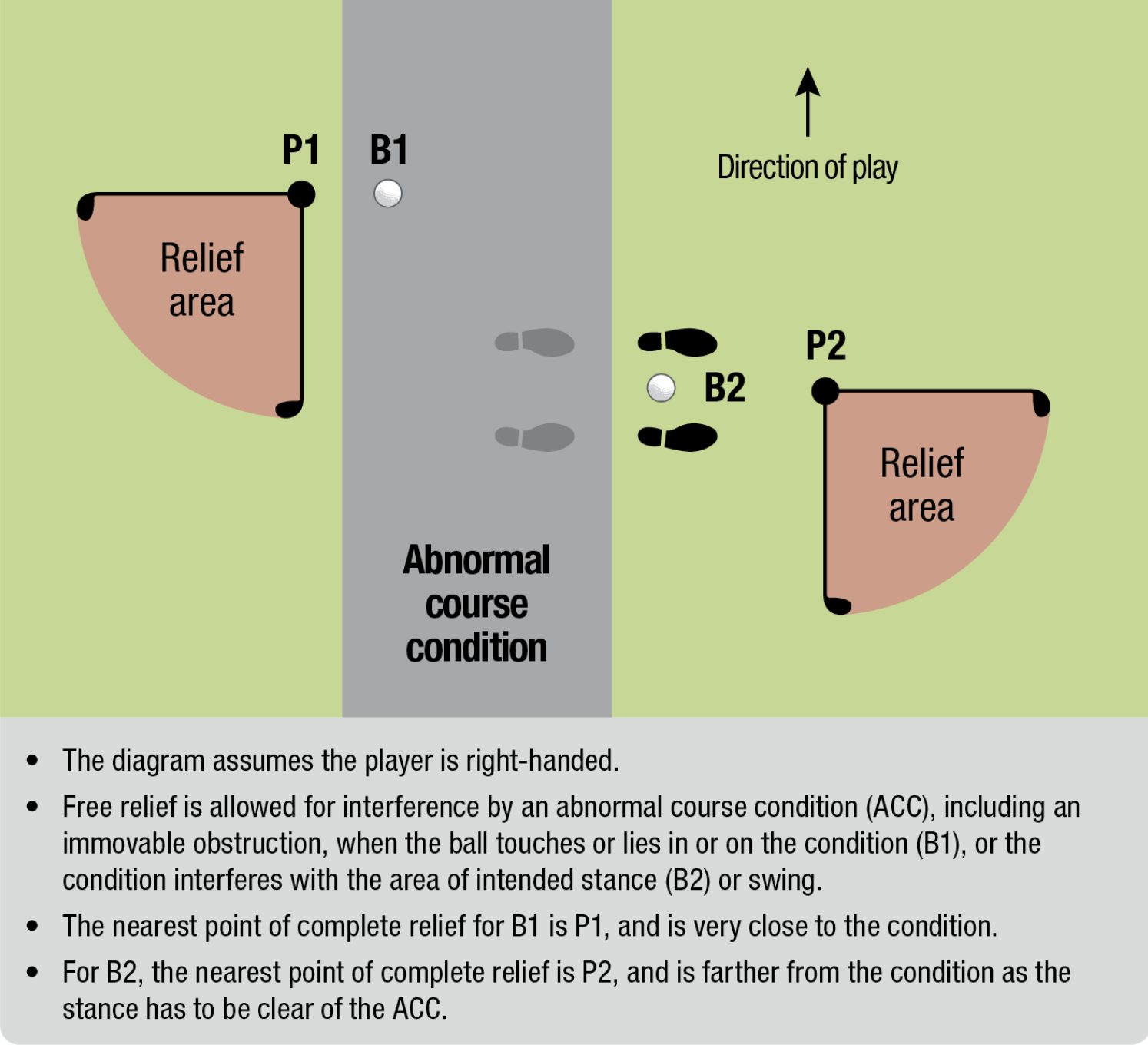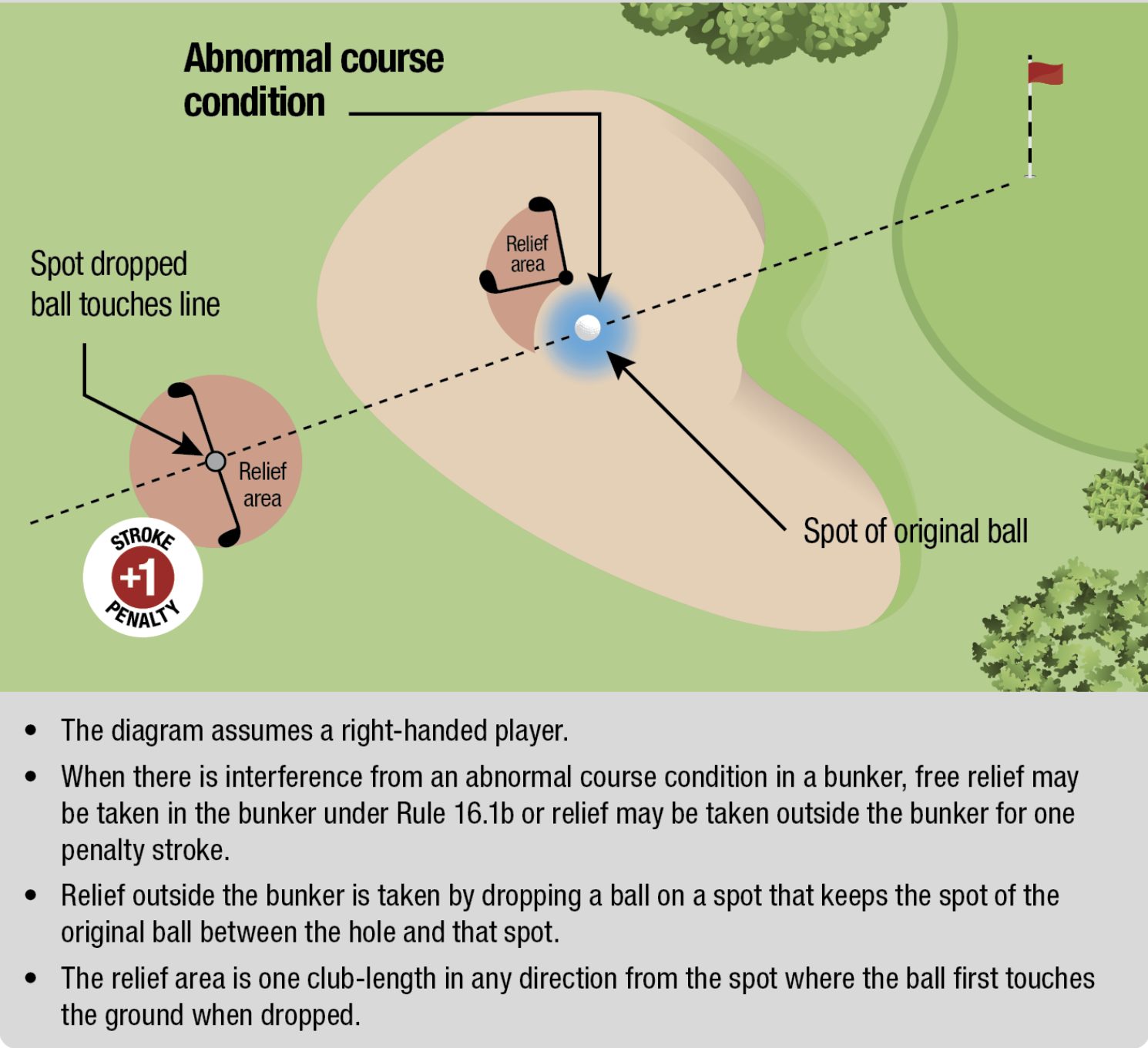Free Relief Situations
Lesson 8 Chapter 8

Free Relief
Loose Impediments
Removing Loose Impediments (Things Like Sticks and Leaves)
You can always move loose impediments (that means natural stuff that’s not attached) anywhere on the course without a penalty.
What counts as loose impediments?
- Sticks, stones, leaves, pine needles
- Loose grass, small branches
- Ant hills, worm dirt, or little clumps of soil
- A bug or spider web on your ball (yes, you can brush that off!)
- Snow and ice – these can be treated as either loose impediments or temporary water (you choose!)
What’s NOT a loose impediment?
- Anything still growing or stuck in the ground
- Sand or loose dirt (that’s different!)
- Dew, frost, or water (they don’t count)
Important Exceptions
- If your ball is moving, you can’t start clearing sticks or leaves to change where it might stop – that’s a 1-stroke penalty.
- If you’ve picked up your ball (like to clean it), you can’t then remove something that would have stopped it from moving before – that’s also a 1-stroke penalty.
- If your ball moves while you’re removing something, you get a 1-stroke penalty and you have to put the ball back. But: No penalty if this happens on the tee box, the putting green, or while searching for your ball.
Moveable Obstructions
- You can remove a moveable obstruction without penalty.
- A moveable obstruction is an artificial object that can be moved easily without damaging the object or the course, like a rake or water bottle.
Exceptions:
- Tee markers cannot be moved when playing from the teeing area.
- If a ball is in motion, you cannot remove a moveable obstruction to affect where the ball goes. A 1 Stroke Penalty will be assessed even if those actions do not affect where the ball lands.
If the ball moves while the player is removing loose impediments:
- There is no penalty, and
- The ball must be replaced to its original lie.


Anywhere on the course (except putting green) you can take free relief if the ball is in or on a moveable obstruction by removing the obstruction and dropping the ball in a one club length area where the ball was originally at rest on the obstruction – in the same area of the course and no closer to the hole.
Abnormal Course Conditions (including Immoveable Obstructions)
- You can take free relief from Abnormal Course Conditions like animals holes, ground under repair (usually marked or called out in local rules sheet), immoveable man made obstructions and temporary water.
- For free relief your ball must be touching or inside the abnormal course condition or it must physically interfere with your swing or stance.
- You can drop your ball in a one club length area (one club circumference) at the nearest point to where you can take a swing or stance and no closer to the hole.

Relief from Abnormal Course Conditions cannot be taken in a Penalty Area or outside the course (for example Out of Bounds).
Abnormal Course Condition in a Bunker
- This is an unusual occurrence but there are relief options!
- If there is an abnormal course condition in the bunker, (e.g. standing water), you can take free relief in same way as above, but you must stay in the bunker.
- For a 1 Penalty Stroke you can take relief outside the bunker. This includes dropping on the line from the hole through where the ball entered the bunker as far back as you like, but no closer to the pin.

Dangerous Animals
- Free relief options are available if you have a “dangerous animal” like a snakes, stinging bees, alligators, fire ants or bears, near your ball as they could cause serious physical injury.
- In these situations you can take free relief at the nearest point of relief away from the danger, no closer to the hole.
- You do not have to recover your ball (for example if it is next to an alligator!). You can use a replacement ball if need be.
Exceptions:
- If your ball is lying in a Penalty Area you can take free relief at nearest point of relief in the Penalty area, however, if you choose to play from outside the Penalty Area you will have the general 1 Stroke Penalty.
- There is no free relief when if your ball is clearly unplayable because of something which you would generally not be allowed relief from (for example your ball is in the middle of a bush).
- There is no free relief if the interference exists only because a player chooses a club or stance that is clearly unreasonable in the circumstances - for example taking a longer club than would be required and/or an extra long stance from the ball to try get feet into an ant hill.
Embedded Ball
- A ball is regarded as embedded if it is in its own pitch mark made as a result of your previous shot and part of the ball is below the level of the ground.
- A ball is not regarded as embedded if it is below the level of the ground as a result of anything other than the player’s previous stroke - e.g.:
- The ball is pushed into the ground by someone stepping on it.
- The ball is driven straight into the ground without becoming airborne.
- The ball is dropped when taking relief.
- Free relief is allowed for a ball that is embedded in the General Area. The general area includes all parts of the course except tee boxes, putting green, bunkers or penalty areas - and therefore includes the rough.
- Relief is taken by dropping the ball directly behind where the ball was embedded within a one club length area not closer to the hole
Exceptions:
- No free relief if your ball is embedded in a bunker or penalty area. Of course, on the putting green you can mark the spot, lift, repair the spot and replace the ball on the mark.
- No free relief if your ball is embedded in a sand area that is not cut to fairway height or less - e.g. sandy waste areas that are not on the fairway.
- No free relief when, if playing the ball as it lies is clearly unreasonable because of something which the player is not allowed to take relief from (for example the player is unable to make a stroke because the ball in a bush.)
Discover more from TheJuniorGolfer.com
Subscribe to get the latest posts sent to your email.